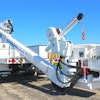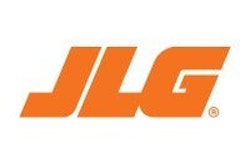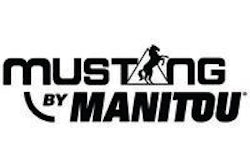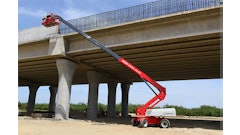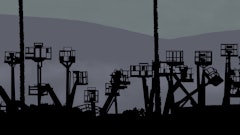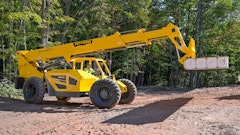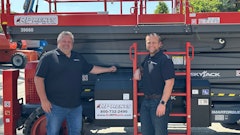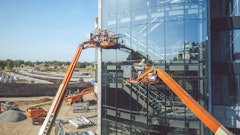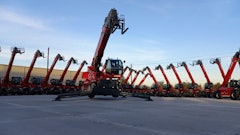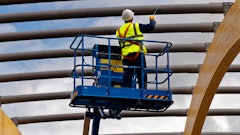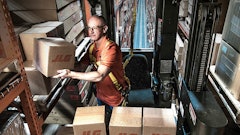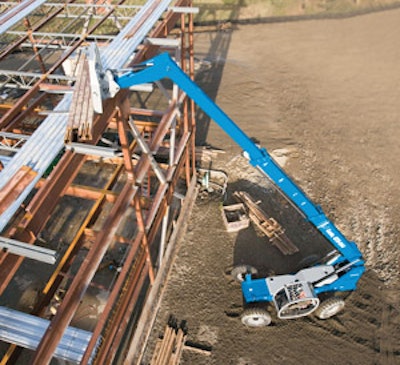
A telehandler is most often used to lift and place materials at a distance other equipment can't readily reach. The one you select for your job needs to match the weight of the material to the height and reach capabilities of the machine.
That sounds fairly basic. Yet, ensuring the right combination of lift capacity and reach for the application is not. A mismatch can prove detrimental to the equipment, to the load and to anyone in the vicinity of the lift.
"Overloading or operating beyond the restrictions of the load chart can have severe ramifications, including dropping the load and/or tipping the telehandler over, or even causing permanent structural damage," says Luke Webber, product manager, Genie Industries. "For the safety of the operator and everyone on the jobsite, it is essential to understand the maximum lifting requirements in advance and select a telehandler designed to handle the expected loads and how high and how far you will be lifting or placing them."
Monitor center of gravity
A telehandler is susceptible to tipping due to overloading/extending because the center of gravity is constantly changing.
"As you raise the boom, the center of gravity will raise higher above the ground," says Steve Kirst, telehandler product manager, Mustang Mfg. "And because it's moving through an arc, the higher you raise the boom, the more the center of gravity shifts toward the back of the machine."
A telehandler is most stable when its "stability triangle" is large, explains Randy Reeves, sales manager, Xtreme Mfg. The stability triangle is the area formed between three imaginary points underneath the machine: one point below each of the two front wheels and one below the rear-axle pivot point. (The rear wheels are not factored into the stability equation because the rear axle typically oscillates.) The telehandler will not tip over as long as the center of gravity of the machine and its load remains inside the stability triangle.
Once you add a load and raise it, the center of gravity moves up and to the rear, toward the more narrow portion of the stability triangle. The higher the load is lifted, the narrower the area of the stability triangle below the load becomes, and the smaller the margin of error.
It may not be intuitive, but one of the most unstable conditions is with the boom fully raised, boom fully retracted and no load, says Lee Kramer, vice president of engineering, Xtreme Mfg. This condition is especially unstable when backing down a grade and when making a turn while on a grade.
Telehandlers are also more prone to tipovers because they are often moving. "Some other lifting machines such as cranes are firmly positioned, which eliminates some of the variables," Kirst points out. "A telehandler is much more maneuverable and susceptible to unsafe situations which an untrained operator may not be aware of. The positions of the load and the center of gravity can change quickly, which affects the stability. That's why it's important for operators to have the training required by OSHA."
Weight, height and reach
The main criteria for ensuring a proper match relate to the weight of the material and lift height and reach required.
Telehandler capacity and reach are inversely proportional, says Brian Boeckman, JLG Industries. "One of the most important things for contractors to understand prior to purchasing or renting a telehandler is the weight of the load they are trying to lift and how high they are trying to lift it," he stresses.
Weight information is available from materials suppliers. "There are some local industry norms, such as how much a bunk of OSB plywood or a cube of blocks weigh," says Kirst. "The difficult and more dangerous ones are unique items such as a big air conditioning unit, a big I-beam or a big wall panel. Then you must size your machine to the worst-case scenario, rather than the typical scenarios."
Once you know the weight of the material, you will need to know how high and how far out you want to lift it. Consider that as a telehandler extends its fork frame beyond its stowed position, its lifting capacity is de-rated by the manufacturer so it can remain stable while being operated on firm level ground, Webber explains.
Some manufacturers incorporate stabilizers on telehandlers to help improve stability while lifting heavier loads. In certain cases, this can improve the lifting capability at maximum horizontal outreach by as much as six times, as is the case with the Genie GTH-1056 (500 lbs. at 42 ft. with stabilizers up and 3,000 lbs. with stabilizers down).
An increasingly common trend is the use of foam-filled tires. "This offers multiple benefits," says Kramer. "It adds more ballast, or weight, at the base of the machine, which can enhance stability. Depending on the size of the machine, it can add 400 to 500 lbs. per tire. Plus, the foam gives you some added tire puncture protection for working in areas with nails, rebar, etc."
Attachment use
Lifting capacity can also be affected by the attachment you're using. The predominant attachment used is forks. Consequently, in most cases, the machine's height and lift capacities are based on traditional 48-in. forks, which equates to a 24-in. load center.
However, one of the benefits of a telehandler is the wide range of attachments, such as truss booms, swing carriages, general-purpose, concrete or grapple buckets, work platforms and personnel baskets.
Each attachment has a unique load capacity. For example, a traditional 12-ft. truss boom has a 144-in. load center, but may only have a maximum lift capacity rating of 2,000 lbs., notes Kirst. "In this case, in addition to knowing how much the load weighs and how high and how far out you want to lift it, you also have to know the capacity of the machine, the load center of the attachment and the rated capacity of the attachment itself," he points out. "Then you can make a judgment based on the safest practices."
These unique attachments can vary widely in weight, size and location of the load center. "These variables all affect the stability of the machine, and frequently affect the lifting capacity in the various lifting zones," Webber states. "The contractor and operator should always verify that the appropriate load chart for the attachment being used is in the cab and in legible condition prior to lifting. The appropriate load chart must be used when preparing to lift a load."
Load charts are available on many manufacturers' web sites and in operator's manuals. And in most models, they're affixed to the dashboard for easy access. "It's up to the operator to know how much he's carrying, how high he's lifting and how far out he's reaching," says Kirst. "He can then plug those values into the load chart to determine whether or not it's safe. Operators should never attempt to do just a little more."
Ensure the right rental
It is very important that all telehandler operators be properly trained on the machine and the use of its load charts.
"Take the time to understand the unique requirements of each jobsite and ensure that operators are trained to use the load chart supplied with each machine," Boeckman emphasizes. "The salesperson at the dealer can assist the contractor in this process, and ensure you receive a machine that will do the job in a safe and productive manner."
The same recommendations apply when renting a telehandler. "Spend some time working with the equipment/rental salesperson to determine the right piece of equipment for your application," says Boeckman.
To further simplify the rental process, Webber advises contacting the rental center as soon as possible once you understand your application as it relates to maximum weight, height, horizontal reach and the use of any special attachments. "That way, they will have enough time to secure the right telehandler for the application," he says. "If the local rental center doesn't have a telehandler that meets or exceeds your needs, contact other rental centers until you find the right machine. One of the biggest mistakes a contractor can make is pushing a telehandler beyond the manufacturer's intended use instead of purchasing or renting one that is more suited for the application."
"Saving money and opting for a smaller machine can push the envelope," agrees Kirst. "Unlike a fuel gauge on your car that tells you when you are about to run out of gas, telehandlers do not have a gauge that tells you when you have exceeded the machine's capabilities - not to mention variables such as uneven terrain, wind and loose soil conditions."

